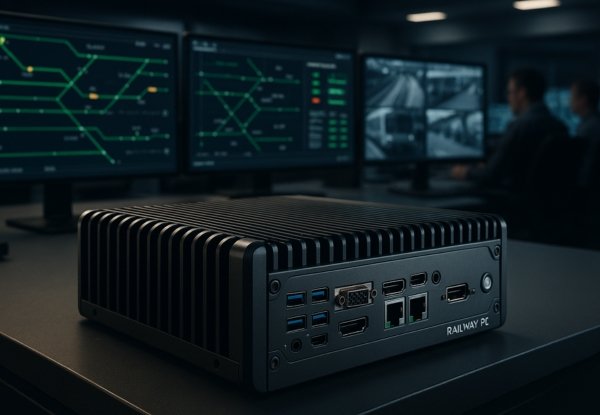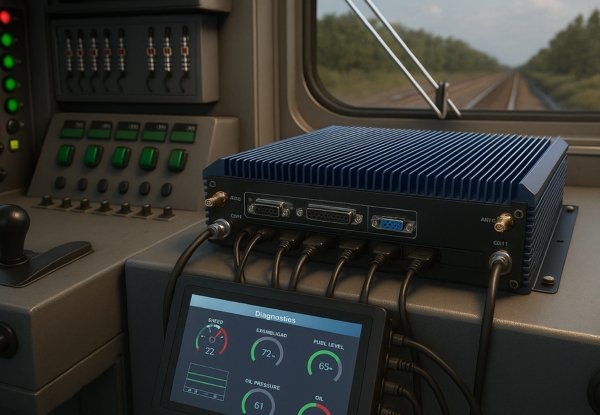Railways are one of the oldest yet most trusted transport systems in the world. With increasing demands for safety, speed, and performance, the technology behind modern train operations is evolving fast. One of the unsung heroes in this upgrade is the Railway PC, a compact but powerful computer built specifically for train environments.
If you’ve ever wondered how modern trains manage real-time communication, safety protocols, or even schedule precision, the answer often lies in a smart, durable computing system onboard: the Railway PC.
Let’s understand what it does and why it’s playing such an important role in shaping the future of railways.
What Is a Railway PC?

A Railway PC is a special type of industrial computer designed for use in railway systems. Unlike regular office desktops, these PCs are tough, weather-resistant, and able to work non-stop in harsh environments like vibrations, temperature shifts, dust, and electrical interference.
These computers are built to:
- Operate 24/7 without failure
- Handle critical train control software
- Connect with sensors, GPS systems, and cameras
- Work even during power fluctuations or extreme weather
They are usually mounted inside locomotives, coaches, or signaling cabins and serve as the brains of various onboard and station-level systems.
Why Trains Need Railway PCs
Modern trains depend on technology more than ever. From engine monitoring to passenger information displays, every smart function in a train runs on precise computing. Here’s where Railway PCs step in.
Some of their major applications include
- Real-time GPS tracking
- Speed and brake control
- Signal communication
- Passenger information systems
- Surveillance and CCTV management
- Diagnostic and maintenance alerts
Key Features of Railway PCs
Not all computers can survive on a fast-moving train or inside a high-voltage signaling room. Railway PCs are specifically built for this kind of environment.
Here’s what sets them apart:
- Shock and Vibration Resistance: Designed to function even when the train hits bumps or high speeds
- Wide Operating Temperature: Can perform in extremely hot or cold conditions
- Fanless Cooling Design: Prevents dust entry and overheating
- Multiple Connectivity Ports: Allows integration with various train systems
- Fail-Safe Operation: Keeps critical systems running without interruptions
Types of Railway PC Use Cases
Let’s look at how different areas of railway operations use Railway PCs.
1. Inside the Locomotive
- Controls dashboard communication
- Monitors engine health in real time
- Supports emergency braking systems
2. Passenger Coaches
- Powers digital information boards
- Supports onboard internet and surveillance
- Tracks door opening/closing functions
3. Trackside Systems
- Works in signaling cabinets
- Manages track-switching mechanisms
- Integrates with centralized traffic control
Benefits of Using Railway PCs
Trains run on tight schedules and strict safety norms. Here’s how Railway PCs help operators meet those standards:
Boost in Safety and Reliability
- Automates alarms for brake issues or engine faults
- Sends live data to control rooms
- Minimizes human error
Improved Passenger Experience
- Real-time announcements and travel info
- Smooth operation of AC, lights, and displays
Reduced Downtime
- Early fault detection via software alerts
- Fewer mechanical failures due to smarter monitoring
Long-Term Cost Savings
- Reduced need for manual checks
- Longer hardware life due to rugged build
Why Railways Need Special PCs, Not Regular Ones
You might wonder, “Why not just use a normal computer in trains?”
The answer is simple: regular PCs aren’t built to handle high pressure, heat, or the constant motion inside a train. Railway PCs come with tested industrial standards like EN 50155, which ensures that they don’t fail in railway conditions.
They’re more than just computers; they are operational control units that keep the train moving, safe, and on time.
How Global Infotech Solutions Supports Railway Automation
Global Infotech Solutions brings experience and technical strength in providing Railway PCs that match industry needs. Our systems are tested, reliable, and ready to handle the demands of the railway sector.
Our offerings include:
- Embedded PCs for train control and monitoring
- Fanless industrial-grade computers
- System integration support for existing setups
If you’re looking for long-term reliability in your train operations, we can help you build a system that works silently in the background but delivers precision at every level.
How to Choose the Right Railway PC for Your Needs
Choosing the right Railway PC depends on your specific application. Here are a few things to check:
- Compliance with EN 50155 and IEC 61373 standards
- Wide voltage input range
- Data protection features
- Durable casing (metal/aluminium preferred)
- Compatible ports (Ethernet, CAN bus, HDMI, etc.)
Also, make sure your supplier offers good service support, because downtime can be expensive in this sector.
Common Mistakes to Avoid
While selecting or using a Railway PC, these errors can lead to performance issues:
- Using standard desktop hardware in train systems
- Ignoring environmental conditions like humidity or vibration
- Skipping regular software updates
- Not planning for future upgrades or connectivity needs
- Overloading the system with too many applications
Avoiding these mistakes will keep your systems stable and your trains running efficiently.
Future Trends in Railway PC Technology
As trains become smarter, so do the systems that power them. Here are a few emerging features you might see:
- AI-powered fault detection
- Remote diagnostics via cloud connectivity
- Touchscreen-enabled driver dashboards
- Real-time data sharing with centralized networks
- Integration with smart city infrastructure
Railway PCs are expected to do even more without getting bigger or more complex to maintain.
FAQs
Q1. What is a Railway PC?
Answer: It is an industrial computer made specifically for trains and railway systems. These devices handle everything from engine monitoring to passenger information.
Q2. How is a Railway PC different from a regular PC?
Answer: Railway PCs are built to withstand harsh conditions like vibrations, extreme temperatures, and electrical noise. Regular PCs are not equipped for such use.
Q3. Where are Railway PCs used in trains?
Answer: They are used inside locomotives, coaches, and control rooms — managing everything from braking systems to display panels.
Q4. Why are rugged features important in Railway PCs?
Answer: Trains experience constant motion, dust, and temperature changes. Rugged features ensure the PC keeps working without failure.
Q5. Can Global Infotech Solutions provide customized Railway PCs?
Answer: Yes, Global Infotech Solutions offers tailored solutions based on the client’s application and budget needs.
Conclusion
Railway PCs are the silent drivers of efficiency and safety across train systems. Whether it’s powering the control panel in the driver’s cabin or keeping passenger information updated in real time, these computers keep the railway network running smoothly.
With growing automation and digital control in rail transport, having a reliable Railway PC isn’t just an upgrade; it’s a necessity. The right system can reduce downtime, improve safety, and enhance passenger experience all while cutting long-term costs.
Choosing the right solution is easier; you have a trusted partner by your side. That’s where Global Infotech Solutions brings real value, delivering purpose-built systems that meet the demanding needs of modern railways.
Take the next step toward smarter, safer train operations. Connect with Global Infotech Solutions and build your system for the future.

